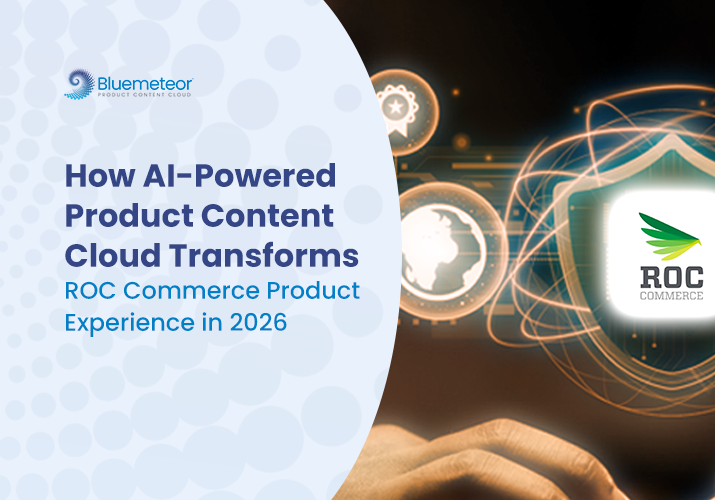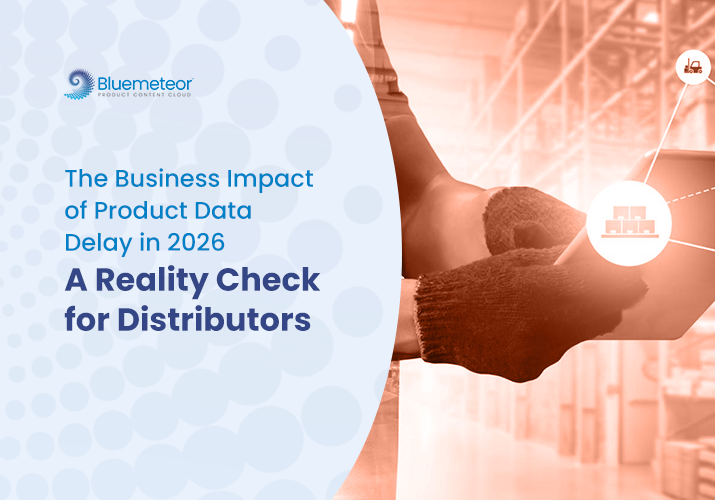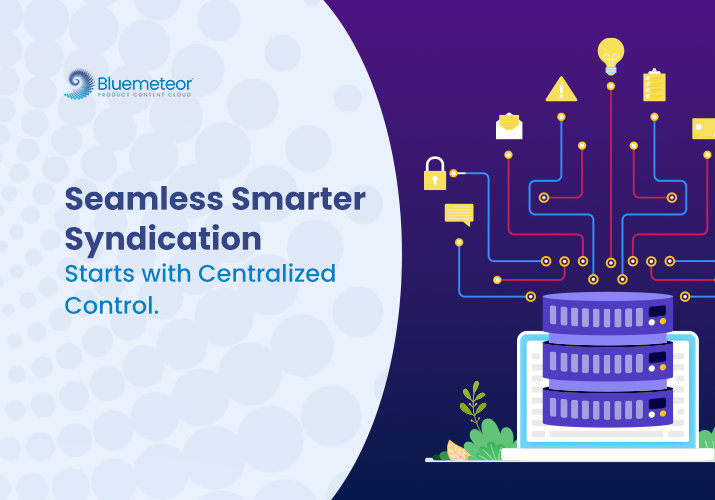What’s Composable Commerce and Why is it critical for growth in 2025?
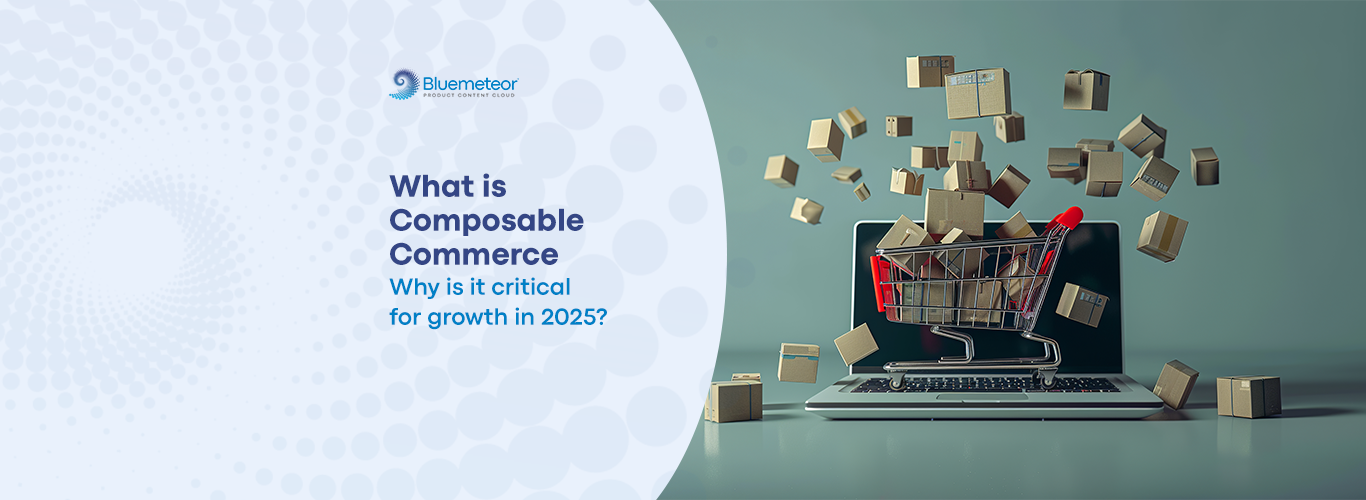
If your commerce platform dictates how you operate, rather than the other way around, you have a problem. The ability to scale, adapt, and compete is now tied to modularity, flexibility, and speed—none of which traditional commerce platforms offer. Composable commerce is the solution.
But it’s not just about swapping software. It’s about rethinking your entire commerce strategy to eliminate bottlenecks and unlock scalable, cost-efficient growth.
This blog breaks down:
- The problems with monolithic commerce and why they stifle growth.
- What composable commerce is and how it transforms operations.
- Real-world business benefits of modular architecture.
- Challenges of adoption (and how to solve them).
- A step-by-step roadmap for seamless implementation.
What’s Wrong with Traditional Commerce Models?
Monolithic platforms (think legacy eCommerce suites) force businesses into rigid, one-size-fits-all structures. While they worked a decade ago, they now create friction and inefficiencies in fast-moving digital markets.
Key Limitations of Monolithic Commerce
| Challenge | Impact on Growth |
| Slow Adaptation to Market Needs | Businesses struggle to add new sales channels, integrate emerging tech, or optimize experiences quickly. |
| Vendor Lock-In | You’re stuck with limited capabilities and must wait for vendor updates or expensive customizations. |
| High Maintenance Costs | Scaling requires expensive upgrades and long development cycles. |
| Inconsistent Customer Experience | A lack of unified data leads to inconsistent product information and fragmented user journeys. |
| Limited Innovation | Businesses can’t test or implement new commerce features without major overhauls. |
When a Commerce Platform Becomes a Liability
A B2B distributor relying on an outdated eCommerce platform struggled to:
- Integrate new marketplaces like Amazon and Alibaba.
- Enable real-time inventory updates across multiple warehouses.
- Implement AI-driven product recommendations.
The result? Lost revenue, frustrated customers, and increasing tech debt.
What Is Composable Commerce?
Composable commerce is a modular approach to building a digital commerce stack. Rather than relying on a single monolithic system, businesses can select and integrate best-in-class solutions—such as a separate PIM, CMS, checkout, or AI-driven search—into a cohesive, scalable ecosystem.
To put it simply, think of it like LEGO blocks. Instead of purchasing a fixed structure, you assemble only the pieces you need, allowing you to customize and upgrade as your business evolves.
Composable Commerce vs. Monolithic Commerce
| Feature | Monolithic Commerce | Composable Commerce |
| Customization | Limited | Fully customizable |
| Scalability | Requires major upgrades | Scales component by component |
| Speed of innovation | slow | fact |
| Cost | High, bundled features | Pay only for what you use |
| Flexibility | Vendor-locked | API-driven, open choice |
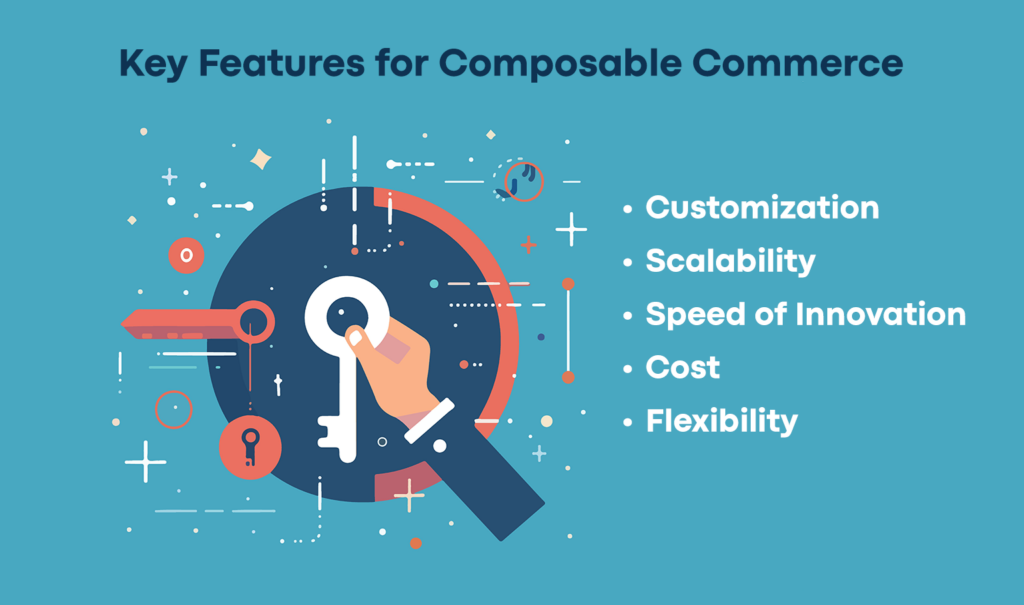
Why Composable Commerce Is Critical for Growth in 2025
1. Composable Commerce: Meeting Customer Expectations Across All Touchpoints
Customers now demand seamless and integrated experiences across a wide variety of channels. They expect to interact with your brand wherever they are, whether it’s on:
- Websites
- Mobile apps
- Marketplaces (Amazon, eBay, etc.)
- Social media (TikTok, Instagram, etc.)
- Physical stores
For manufacturers and distributors, this presents a major challenge. In other words, traditional commerce platforms were never designed to support the level of omnichannel complexity that businesses face today. Consequently, this mismatch creates significant barriers for companies striving to adapt to modern customer demands.
So, what does this mean?
With composable commerce, businesses can seamlessly integrate multiple sales channels without the headache of overhauling entire back-end systems. Moreover, it provides the flexibility to build an architecture that specifically aligns with unique business needs. This means businesses can adapt quickly to changing demands, ensuring they stay competitive in an evolving market.
But why is this important?
By embracing composable commerce, businesses can not only keep pace with changing customer expectations but also quickly launch new channels as needed, ensuring they stay ahead in an evolving market.
Example: Imagine, for instance, a manufacturer that wants to launch a B2B eCommerce platform, offer self-service customer portals, and incorporate AI-powered product recommendations. With composable commerce, this can happen quickly and efficiently, without waiting for months for a system-wide update. In fact, businesses can simply select and implement the necessary components, enabling these capabilities right away. This flexibility allows companies to rapidly address specific needs and scale as required, rather than being held back by a rigid, monolithic platform.
2. Speed Matters More Than Ever
The digital landscape is moving faster than ever before, and businesses must adapt quickly to remain competitive.
What does this mean? Time is money, and slow-moving platforms can cost your business more than just lost time—they can cost you your market position.
With composable commerce, businesses can launch, test, and scale new features in a fraction of the time compared to traditional platforms.
Why is this crucial? businesses need to respond to market shifts, customer demands, and technology advancements immediately—rather than waiting for months or even years just to receive an update from a monolithic platform.
How does it work? With composable commerce, you can:
- Deploy new features in weeks, not months.
- Quickly adapt to market trends without being held back by rigid technology.
- Integrate AI and automation on your own timeline, instead of waiting for a legacy platform to catch up.
By embracing composable commerce, your business can keep innovating without being bogged down by outdated systems.
3. AI and Automation Are Reshaping Commerce
Artificial Intelligence (AI) and automation are reshaping how businesses operate in the digital space.
But many traditional platforms simply cannot keep up with the rise of:
- AI-driven personalization, like dynamic product recommendations.
- Predictive analytics for more accurate demand forecasting.
- Automated customer support, such as AI chatbots and self-service portals.
What does this mean for your business?
If your commerce platform isn’t capable of supporting these advanced technologies, you’re missing out on key opportunities to improve customer experience and optimize your operations.
How does composable commerce solve this issue? Well, with composable commerce, businesses can seamlessly integrate AI and automation at their own pace.
Unlike a monolithic system that’s slow to adopt new technologies, composable commerce offers the flexibility to stay ahead. Instead of waiting for system-wide updates or dealing with compatibility issues, you gain the freedom to adopt best-in-class AI tools exactly when you need them. As a result, your business remains agile, innovative, and always ready for the next big technological shift.
4. Cost Efficiency: Pay for What You Actually Use
One of the most frustrating aspects of traditional commerce platforms is that they often bundle unnecessary features. As a result, businesses are forced to pay for functionalities they don’t need or use.
But what is the real cost?
In reality, you’re paying for a one-size-fits-all solution—whether or not it actually works for your business. On the other hand, composable commerce allows businesses to select only the components they need and scale as necessary, ensuring greater flexibility and cost efficiency.
This means:
- You pay only for what you use, avoiding the cost of unnecessary features.
- You can scale individual components instead of overhauling the entire platform.
- You can reduce long-term maintenance costs by only keeping the tools that matter to your business.
Businesses shouldn’t be forced to pay for features that don’t align with their needs. With composable commerce, you’re able to control costs while ensuring you’re investing in the technologies that will truly drive your business forward.
“The most expensive system is the one that stops your business from growing.”
Challenges of Composable Commerce (And How to Overcome Them)
1. Integration Complexity
When different components don’t communicate properly, it leads to data silos and inefficiencies that can bring operations to a halt.
Imagine having customer data stored in one system, inventory management in another, and order tracking somewhere else—each one working in isolation.
The result?
- Disjointed processes
- Inaccurate insights
- Delayed decision-making
How to Overcome It:
- Adopt an API-first approach: This ensures that all your systems are talking to each other seamlessly.
- Enable real-time data synchronization: With tools like PIM (Product Information Management) and PXM (Product Experience Management), you can ensure your product data is always up-to-date across all channels.
- By streamlining data flow, you’ll create an integrated ecosystem that boosts efficiency, reduces errors, and enables faster decision-making.
2. Internal Resistance to Change
Change can be tough, especially when it disrupts established workflows. As a result, teams might be reluctant to adopt a new system that requires them to rethink how they work. Consequently, this resistance can slow down the implementation process, ultimately making it harder to reap the benefits of composable commerce.
How to Overcome It:
- Roll out the changes in phases: First, avoid overwhelming your teams with an all-at-once transition. Instead, gradual implementation ensures smoother adjustments, helping your teams adapt more easily.
- Offer training and hands-on sessions: Next, empower your teams with the right tools and knowledge. By doing so, you ensure they feel confident and prepared in their new workflows.
- Pilot testing: To begin, start small with a select team. Gather feedback, make improvements, and once the pilot is successful, then you can scale it across the organization.
Ultimately, this approach not only helps ease concerns but also encourages buy-in, ensuring that everyone is on board with the new systems.
3. Too Many Vendor Choices
Given the countless solutions available, it’s easy to feel paralyzed by choice. Thus, the risk lies in selecting a tool that doesn’t integrate well with your existing systems or, worse, one that fails to meet your specific needs.
How to Overcome It:
- Work with a commerce strategist: A strategist can help you navigate the vendor landscape, aligning solutions with your business goals and tech requirements.
- Opt for pre-integrated solutions: By choosing tools that are already compatible with each other, you minimize the risk of integration issues and reduce the need for excessive customization.
- This approach helps streamline your stack, reduce vendor mismatches, and simplify management, ensuring a more cohesive and effective system.
How to Transition to Composable Commerce
Transitioning to composable commerce might seem daunting at first, but the process can be smooth if you break it down step by step. Here’s how to do it in a way that aligns with your business needs and future goals.
Step 1: Audit Your Current Tech Stack
Before diving into composable commerce, it’s important to first take a step back and assess your current situation. Evaluate your existing systems and pinpoint where they’re struggling to keep pace with your growth.
Is your tech stack slowing down your processes?
Are you facing challenges with scalability, speed, or omnichannel capabilities?
By identifying these bottlenecks, you’ll gain valuable insight into where change is most urgently needed.
Key Questions to Consider:
- Are there any systems that have become outdated or inefficient?
- What’s preventing you from scaling or innovating?
- Do your current tools offer the flexibility to expand into new sales channels or incorporate AI?
Once you’ve identified where your current tech stack falls short, the next step is to determine which legacy systems need to be replaced or upgraded.
For instance, this might mean replacing an outdated PIM system, addressing issues with a slow CMS, or upgrading an order management system that can no longer handle high volumes effectively.
Step 2: Define Your Business Priorities
Every business is different, so take a moment to really think about what’s essential for your growth in 2025 and beyond.
What features are going to drive the most value for your business, and what areas need immediate attention?
Key Questions to Ask:
- What are the most crucial features for my customers’ experience?
- Are there components of my eCommerce platform that need immediate upgrades to stay competitive?
- What capabilities will enable me to scale faster and keep up with customer demand?
Whether it’s better product data management, real-time inventory updates, or AI-driven personalization, define what matters most to your business. This step helps you make sure your transition is aligned with your growth strategy, not just a bunch of new tech for the sake of it.
Step 3: Implement in Phases
You don’t have to overhaul everything at once. In fact, composable commerce works best when you take a phased approach. Start small and gradually scale up over time.
Here’s how you can do it:
Begin with the essential components: product information management (PIM), content management systems (CMS), checkout, and order management. These are the core systems that keep your eCommerce engine running smoothly.
Key Tips:
- Prioritize the components that will have the most immediate impact on your operations.
- Avoid trying to integrate everything all at once. Focus on getting the basics right first.
- Use this phase to ensure that the foundational systems are working well together before moving on to more advanced tools.
Once you’ve got the basics sorted, you can then gradually begin integrating more complex systems, such as AI, automation tools, or advanced analytics. By doing so, you can build your system step by step, ensuring that each piece seamlessly fits together.
With composable commerce, this incremental growth approach is crucial, as it allows you to scale at a sustainable pace while avoiding overwhelming changes. Ultimately, this thoughtful strategy is key to ensuring long-term success.
Step 4: Ensure Data Consistency
One of the most frustrating aspects of traditional commerce platforms is that they often bundle unnecessary features. This forces businesses to pay for functionalities they don’t need or use.
Why does this matter?
Consistency in product data not only enhances the customer experience but also empowers smarter decision-making. Accurate and consistent data ensures that you have the correct product information across all platforms, reducing errors and building trust with your customers.
Key Questions to Ask:
- Do I have a single source of truth for product data?
- Are my systems communicating effectively, or is there data fragmentation?
- How can I ensure my data stays up-to-date in real time?
When your systems are well-integrated and your data is streamlined, your business becomes more agile, enabling a seamless customer experience across all channels. With composable commerce, you gain full control over what gets updated and when, ensuring that you’re always ahead of the curve.
How Bluemeteor Helps Manufacturers & Distributors Scale Smarter
Composable commerce sounds great in theory, but in reality, it only works if your product data is structured, accessible, and scalable. Without a strong foundation, even the most flexible architecture will struggle to deliver a seamless experience.
That’s where Bluemeteor’s Product Content Cloud comes in.
Here’s how it empowers manufacturers and distributors to unlock the full potential of composable commerce:
- A Single Source of Truth for Product Data – No more scattered spreadsheets or disconnected databases. Product Content Cloud centralizes all product information, making it easier to manage, update, and syndicate across multiple sales channels.
- Eliminates Data Silos for a Seamless Experience – Whether it’s your eCommerce store, marketplace listings, or distributor portals, product information remains consistent, accurate, and up to date everywhere.
- Faster Syndication to Marketplaces & B2B Portals – With pre-built connectors and automation, getting your product data live on Amazon, Alibaba, Grainger, and other platforms is faster and hassle-free.
The bottom line? Your composable commerce strategy is only as strong as your product data.
If your data is a mess, your commerce experience will be, too.
Want to see how Bluemeteor can help unify your product data and make composable commerce work for you? Book a free demo today!
Final Thought: The Risk of Ignoring Composable Commerce
Composable commerce isn’t just about technology—it’s about growth, agility, and survival. Businesses that fail to adapt risk falling behind faster than ever before. The question isn’t if you should adopt it, but how fast you can make the shift.
Are you building for scalability with composable commerce or maintaining a system that limits you?

